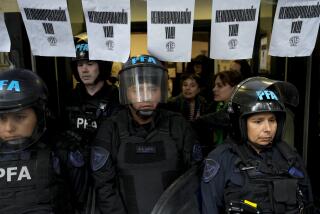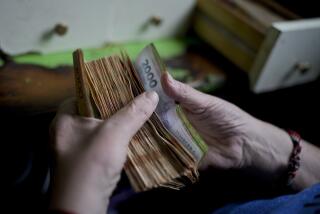Market Focus : Vending Machines Jingle in Argentina : The nation’s new economic stability means that coins actually have value after years of inflation.
- Share via
BUENOS AIRES — Since October, Alejandro Martin has sold more than 130 American-made vending machines, the kind that swallow coins and give out coffee, soft drinks or snacks.
Martin’s business is not soaring, but it’s getting off the ground--something that would have seemed impossible in Argentina during past decades, when inflation of triple and even quadruple digits rapidly reduced the value of coins.
Coin vending machines are a sign of new times. In the past 12 months, Argentine inflation totaled only 4.3%, the lowest rate since 1953. Monthly inflation rates in the past six months have averaged less than 0.1%. Thanks to the government’s monetary stabilization program, 50 centavos will buy the same candy bar it bought half a year ago, making vending machines practical for the first time in a generation.
Controlling inflation has been one of the main achievements of President Carlos Menem and his economy minister, Domingo Cavallo. And monetary stability obviously is good for business: The Argentine economy grew a robust 7% last year.
Martin said the stability and growth, together with the untapped potential of vending machines, make his company’s future a promising one, though not without problems. He is commercial manager of Vendor Argentina, a joint venture of Argentine investors and the Des Moines, Iowa-based Wittern Group of 32 vending machine manufacturing, marketing and servicing companies.
“Our market is going to be a big market,” Martin said. “But it is not going to be very easy to expand.”
Vending machines are a new concept for Argentines who have watched coins quickly become worthless over the years. When Buenos Aires buses recently began operating with automatic coin boxes--another sign of the times--one of the biggest problems was riders boarding without the right change.
“We are changing maybe 40 or 50 years of tradition,” Martin said. “This is a very big change, and people need to be educated to get used to using coins.”
*
By betting that such a development is coming, he said, Vendor Argentina is putting “100% confidence in the Argentine economic plan and the stability of the currency.”
Some economists, however, see danger signs in the economy, including an overvalued peso, a growing trade deficit and a slowdown in the flow of capital into the country.
In 1991, Economy Minister Cavallo unveiled a stabilization plan that guarantees convertibility of the Argentine peso at one to a U.S. dollar. But it took time to convince the marketplace of the peso’s stability. In the first two years under the plan, retail prices climbed.
That has made many Argentine products and services overpriced in dollars and has set off a series of related results familiar to volatile economies. As a result, for instance, some of the country’s exports are less competitive on international markets, and imports are cheaper. Argentina’s trade deficit rose to a record $3.7 billion last year and is expected to keep climbing this year.
So far, the investment and financial funds coming into the country have covered the trade deficit, but economists say the capital flow is slowing. Recently increased interest rates in the United States make Argentina’s stock market, bonds and other investment instruments less attractive than they were last year, economic analysts say.
To draw funds for development, the Argentine government and private sector now must pay higher interest rates themselves. “The financial cost of restructuring the economy has gone up,” said Osvaldo Cortesi, a partner in the Macroeconomica consulting firm.
If the trade deficit continues to climb and capital inflow wanes, pressure may mount for a peso devaluation. But a devaluation would bring a serious risk of renewed inflation. In the past, Argentine retailers traditionally pegged prices to the dollar value of the peso, and if the peso-dollar parity is broken, that tradition is likely to return, economists say.
Menem is expected to do everything possible to avoid a devaluation and the risk of inflation before presidential elections, to be scheduled for sometime early next year. Menem hopes to run for a second term, and a surge of inflation could undermine his popularity, which has been based in large part on the success of his economic policy.
*
Eventually, however, the government will have to do something to increase exports, said Walter Stoeppelwerth, senior financial analyst at the Smith New Court stock brokerage in Buenos Aires. Stoeppelwerth noted that Argentine exports account for less than 5% of the country’s total economic production, a tiny proportion compared with other rapidly developing countries.
Government officials say tax cuts and increased efficiency can make Argentine exports more competitive without the need for a devaluation. But Stoeppelwerth and other analysts aren’t convinced that monetary stability is here to stay.
“I’ll believe it when I can buy a Coke from a machine with coins,” he said.
Argentine Inflation
Now that inflation has climbed down from the days of quadruple-digit figures, the use of coins is returning. Here’s a look at the dramatic change in Argentina’s inflation over the past decade.
*
Increases in Official Consumer Price Index
1984: 688.0%
1985: 385.4%
1986: 821.9
1987: 174.8%
1988: 387.7%
1989: 4,923.3%
1990: 1,343.9%
1991: 84.0%
1992: 17.5%
1993: 7.4%
*
Source: Argentine government
More to Read
Sign up for Essential California
The most important California stories and recommendations in your inbox every morning.
You may occasionally receive promotional content from the Los Angeles Times.













